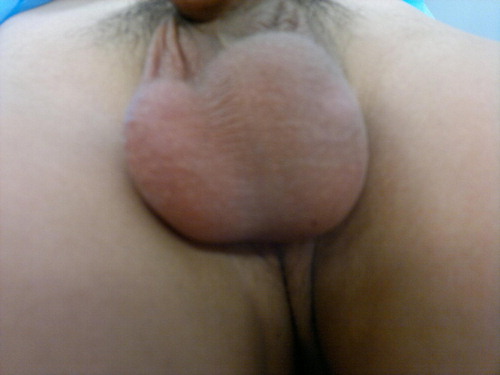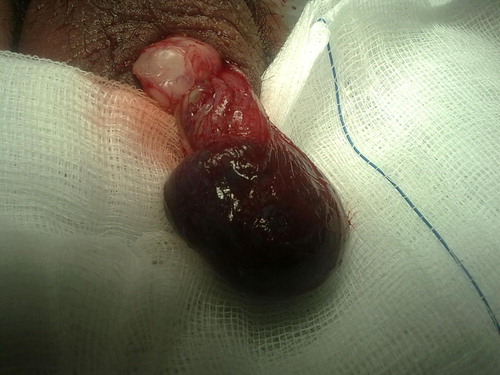Abstract
Objectives
There are many causes of acute scrotum that should be diagnosed and promptly managed because testicular loss might affect fertility. In this study I notified the time of onset of symptoms, time of presentation, management and operative findings to assess the importance of early presentation and early exploration.
Methods
Records of 62 consecutive boys under 14 years of age treated for acute scrotum at Prince Rashid bin Al-Hassan hospital in three years (2008–2010) were reviewed. During the period studied all patients with acute scrotum that underwent surgical exploration of the scrotum have been studied. The duration and characteristics of the symptoms, clinical findings prior to operation, the age of the patients and the operative findings were registered.
Results
Scrotal explorations revealed 15 cases (24%) of spermatic cord torsion, 30 cases (47%) of torsion of the testicular appendage, 6 cases (10%) of epididymitis, 5 cases (8%) of incarcerated inguinal hernias and 6 (11%) other conditions. In six cases of spermatic cord torsion the testicle was gangrenous and underwent hemiorchidectomy.
Conclusion
The relatively high risk of testicular torsion and testicular loss in cases of acute scrotum in children signifies the importance of the early exploration and immediate management.
1 Introduction
Testicular torsion is an abnormal rotation of the testis and spermatic cord resulting in acute, severe scrotal pain due to decreased or even complete loss of blood flow to the affected testicle. The incidence of testicular torsion increases between the ages of 12 and 18 years, but it can be seen in any age group, and it is estimated that 1 out of every 4000 men below the age of 25 will have torsion of the testis.Citation1 Testicular torsion is common in the undescended testicle.
The proper management for a patient with testicular torsion requires early presentation, prompt diagnosis, and curative intervention. The surgical procedure would be scrotal exploration orchiectomy for nonviable testicle and orchidopexy viable testes. The delayed presentation is the major obstacle to the suitable management. The diagnosis of testicular torsion depends on the patient's history, physical examination and imaging studies. Color Doppler ultrasonography is a helpful tool to differentiate torsion from other causes of an acutely painful scrotum.Citation2 The objectives of this study are to emphasize the role of early presentation and early exploration to conserve the torsed testicle.
2 Methods
The medical records of 62 boys under 14 years of age treated for acute scrotum at Prince Rashid bin Al-Hassan hospital in three years (2008–2010) were reviewed. During the period studied all patients with acute scrotum that underwent surgical exploration of the scrotum have been studied. Those who had been admitted for scrotal pain and managed non-operatively were excluded. The duration and characteristics of the symptoms, clinical findings prior to operation, the age of the patients and the operative findings were reported. The operative diagnoses were interpreted with focusing on the testicular torsion and the resulting gangrene of the involved testicle. Twenty seven cases were explored by general surgeon and the rest of cases were managed by pediatric surgeons. No neonatal cases were found in the study; mostly because the neonates who need operative procedures were used to be transferred to the referral King Hussein medical center. The Doppler ultrasound result was not figured because the study is focusing on the operative findings upon scrotal exploration.
All patients presented within three days of the onset of symptoms, all had the complaints of scrotal pain and 38% of them had also scrotal swelling.
3 Results
Fifteen patients of those who had been explored were found to have spermatic cord torsion. Six patients had unfortunately gangrenous testicles and underwent hemiorchidoectomy and orchidopexy for the remaining testicle ( and ). All the six patients presented after 24 h from the onset of symptoms, except for two presented early but mismanaged as epidydimitis. The other nine cases with viable testicles had presented within 24 h of the onset of their pain; six patients had presented within less than 6 h and were managed by bilateral orchidopexy. Regarding their age, twelve boys were between 12 and 14 years, two were 11 years old and one patient was 10 years old. The patients who underwent orchectomies are followed in the outpatient clinic with no complaints.
Thirty patients were found to have torsion of the testicular appendages; seventeen cases were 5–10 years old, two cases less than 5 years and 11 cases were above 10 years.
In six cases the operative diagnosis was epidydimitis with four patients above 10 years old. Five cases presented with acute scrotal swelling and found to have incarcerated hernias one of them was diagnosed after exploration.
Four cases were found to have normal testicles and diagnosed as idiopathic scrotal edema following exploration. Two cases were explored for blunt scrotal trauma.
4 Discussion
The incidence of testicular torsion is about 1 in 4000 malesCitation1 caused by congenital anomaly of the processus vaginalis called clapper-bell deformity. It occurs in the absence of precipitating factors in most cases,Citation3 but some factors may predispose patients to torsion including age (peripubertal), testicular tumors, cryptorchidism and the horizontal lie of the testicle.Citation4
The extravaginal torsion occurs exclusively in newborns when the testis and gubernaculum can rotate freely. Its incidence is one in 7500 newborns. Neonates with testicular torsion present with scrotal swelling discoloration, and with a firm painless mass in the scrotum because the testis is usually necrotic and infracted.Citation5
The most consistent symptoms of testicular torsion are sometimes associated with nausea vomiting, and low-grade fever. On physical examination the hemiscrotum of the affected side is typically swollen () tender, and inflamed, with an absent cremasteric reflex, and tenderness unrelieved by elevation of the scrotum.Citation6
Color Doppler ultrasonography is the imaging modality of choice to evaluate a patient with acute scrotum and to diagnose testicular torsion with accuracy rate of 97% for detecting intra-testicular blood flow.Citation7 But it is operator dependent imaging tool with a significant number of false negative diagnoses.Citation8
Immediate surgical exploration is the standard treatment with bilateral orchidopexy if the testis is viable and hemiorchectomy for the infracted non viable testicle. The testicular salvage is related to the duration and the degree of torsion. The salvage rate may be as high as 100% if the testicle is explored within 6 h from the onset of symptoms. If the intervention is made within 6 to 12 h testicular salvage rates decrease to 70% and from 12 to 24 h it is diminished to20%.Citation9
In this study the salvage rate was 60% and all patients who were explored after 24 h had gangrenous testicles (). The main cause for this result was the delayed presentation to the hospital to seek for the proper management. The other cause was the mismanagement of two patients who lost their torsed testicles.
There are other studies that recommend early exploration of all cases to ensure the maximal testicular salvage.Citation10
5 Conclusion
Testicular torsion is a treatable emergency but might lead to testicular loss and impaired fertility. That risk necessitates the immediate management of the acute scrotum and considering the early exploration the best treatment to conserve the testicle.
Notes
Peer review under responsibility of Alexandria University Faculty of Medicine.
Available online 6 July 2012
References
- E.RingdahlL.TeagueTesticular torsionAm Fam Physician74200617391743
- L.A.BakerD.SigmanR.I.MathewsJ.BensonS.G.DocimoAn analysis of clinical outcomes using color Doppler testicular ultrasound for testicular torsionPediatrics1052000604607
- H.D.NoskeS.W.KrausB.M.AltinkilicW.WeidnerHistorical milestones regarding torsion of the scrotal organsJ Urol15919981316
- J.D.ArceM.CortesJ.C.VargasSonographic diagnosis of acute spermatic cord torsion. Rotation of the cord: a key to the diagnosisPediatr Radiol322002485491
- C.E.HawtreyAssessment of acute scrotal symptoms and findings. A clinician's dilemmaUrol Clin North Am251998715723
- T.L.WashowichSynchronous bilateral testicular torsion in an adultJ Ultrasound Med202001933935
- G.D.LukerM.J.SiegelScrotal US in pediatric patients: comparison of power and standard color Doppler USRadiology1981996381385
- Chair V 2008, Testicular torsion: imaging, Retrieved 2009 May 23, Available from: http://www.emedicine.medscape.com/article/381204-imaging.
- H.B.PatriquinS.YazbeckB.TrinhS.JequierP.N.BurnsA.GrignonTesticular torsion in infants and children:diagnosis with Doppler sonographyRadiology1881993781785
- F.L.MurphyL.FletcherP.PeaseEarly scrotal exploration in all cases is investigation and intervention of choice in the acute paediatric scrotumPediatr Surg Int52006413416

